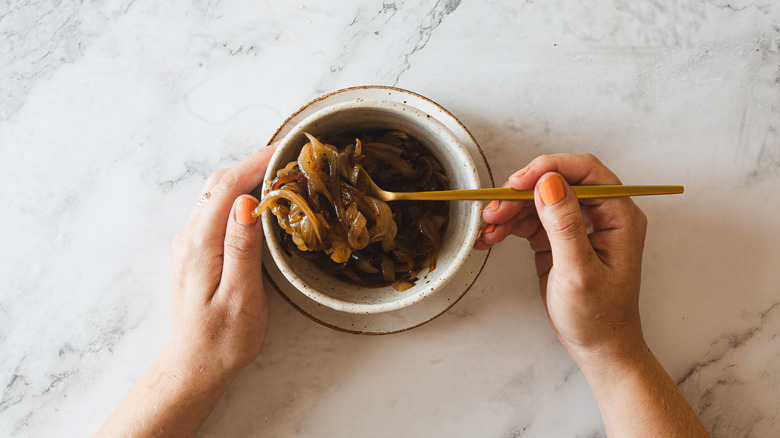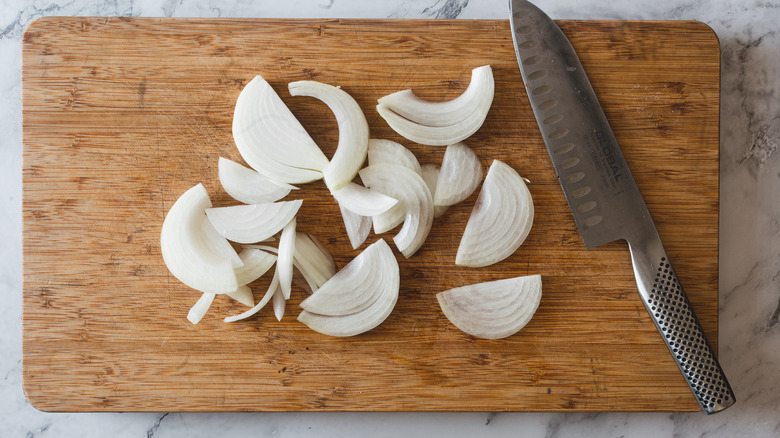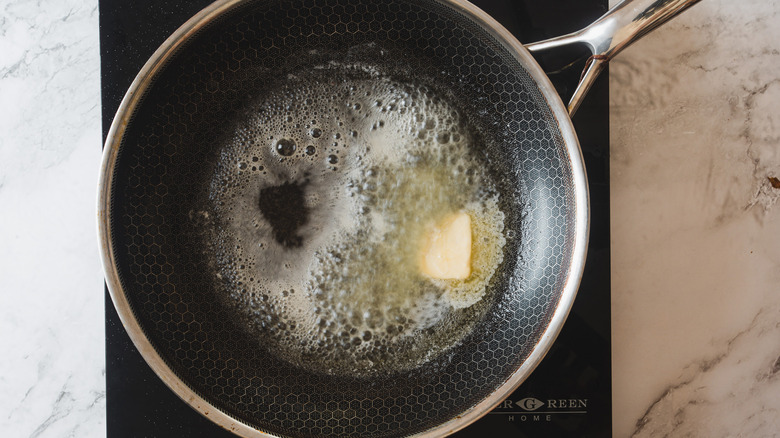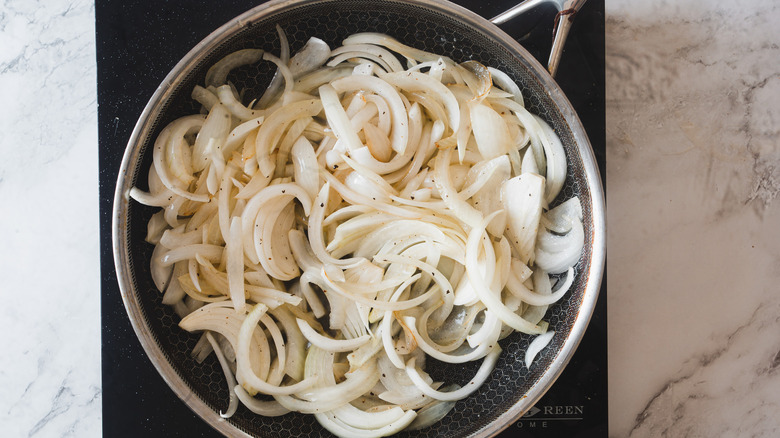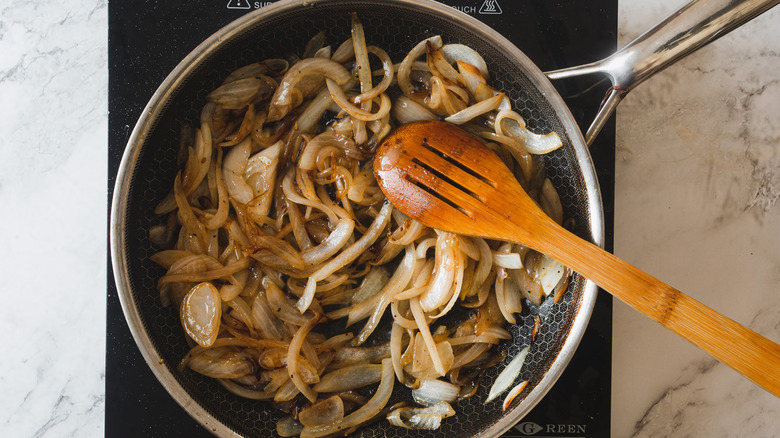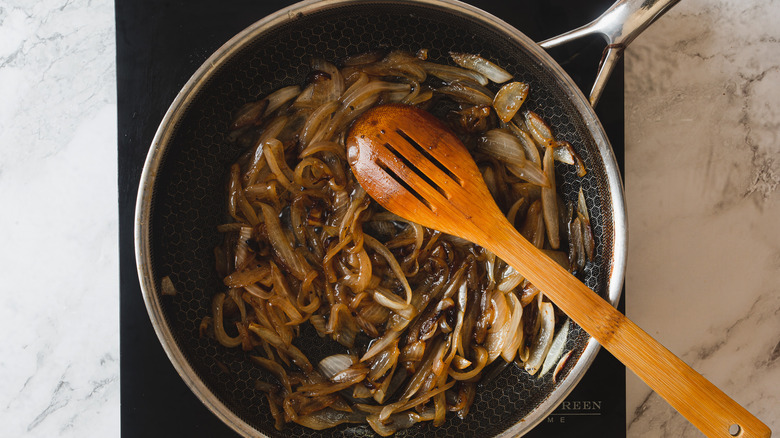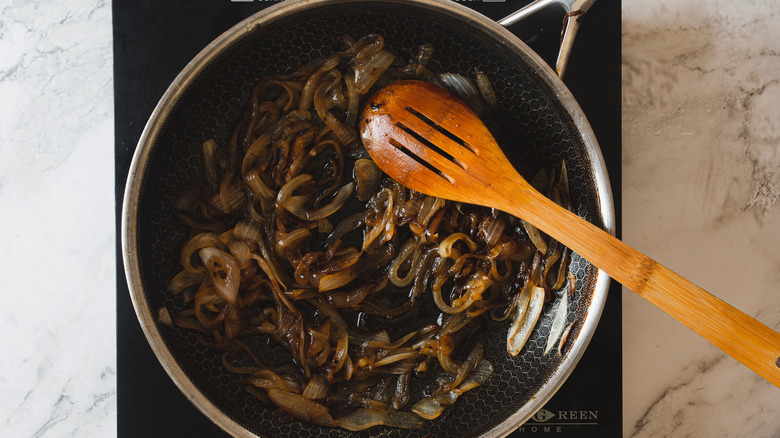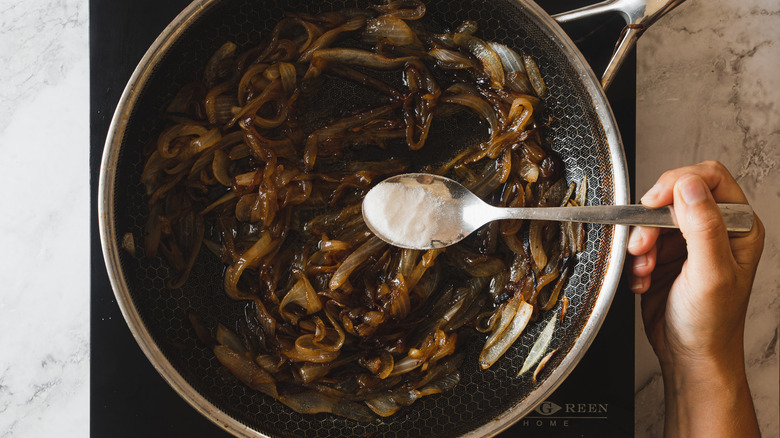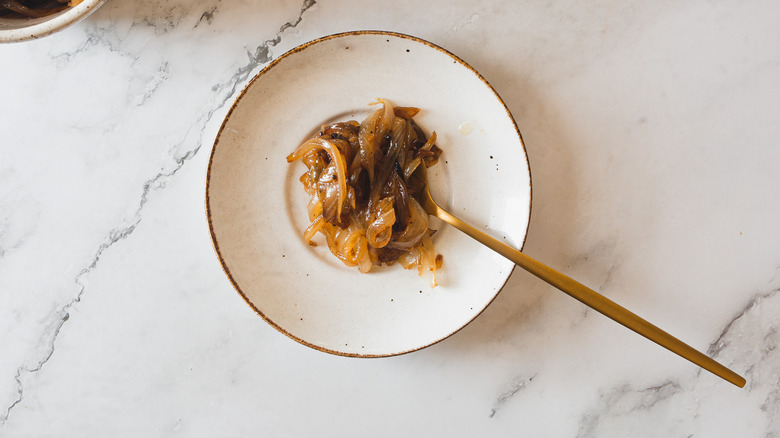How To Saute Onions
The perfect sautéed onions are nature's candy, says food blogger and photographer Ksenia Prints of At the Immigrant's Table. Whether you are sautéing onions for a quick stir fry, hoping to just change their color, or whether you are going for the full monte — that is, producing some beautifully slick, browned caramelized onions, drowning in their own puddle of delicious, jammy sauce — learning how to sauté onions is one of the first steps to being successful in the kitchen. Sure, it sounds simple, but knowing how to sauté onions just so can mark you out as an especially accomplished home chef.
Onions are also usually one of the first building blocks of a savory recipe, helping to build up flavor in things like stews, soups, stir fries, and much, much more. So let's take the time to learn how to sauté onions without burning them. We also have some tips on how to get around the usual hour-long process by learning some helpful shortcuts to sautéing onions fast.
Cut the onions into slices
First, peel the papery skins off of your onions. Then, cut your onions in half vertically, from the top to the roots.
Rest your onions face down on the cutting board. Working horizontally and moving across the onion, slice the onion into thin slices of no more than ¼ or ½ inch thick. And, yes, size can make a difference here, especially if you want to easily brown onions or cook them relatively quickly. Thin onion slices are especially crucial for perfectly cooked caramelized onions.
What's the best oil for sautéing onions?
Though it may seem like a great topic of debate, the truth is that you don't necessarily have to pick between oil or butter when it comes to cooking up these onions. We actually love sautéing onions in both oil and butter combined. Oil helps to prevent the onion from burning, ensuring a lengthy cooking process will go over well. Meanwhile, butter imparts a sweetness and rich flavor to the onions that you just can't get otherwise.
If, however, you want to only use one fat kind to sauté your onions, then be sure to go for a neutral oil like grapeseed oil or canola oil. More strongly flavored oils may alter both the cooking process and the final taste of your onion mixture.
Add onions to the pan with oil and butter
Set a non-stick pan on the stove and turn it up to medium heat. Add the oil and butter to the pan and wait for them to melt. When that's happened, add enough onions to the pan that you fill the bottom without crowding or overlapping slices.
Though it may be tempting to dump the whole pile into the pan and get on with cooking, don't do it! This will create steam that will boil your onions instead of caramelizing them, meaning you'll miss out on all that great flavor. Instead, it's better to work in batches.
Cook the onions, stirring occasionally, for 1-2 minutes, until their color starts to turn translucent and the onions have begun to reduce in size. Then, you can add more onions to the pan. Repeat this process until you are all out of raw onion slices.
Cook the onions for 20 minutes
Once all your onions are in the pan and have become translucent, lower the heat to medium-low.
Continue cooking the onions, stirring them often, for about 20 minutes. After this time, you will end up with yellow-golden onions that still retain some texture.
Cook the onions further for medium caramelization
If you are looking for perfect, brown caramelized sautéed onions that are sweet and soft, continue cooking the onions for another 15-20 minutes.
Be sure that you are stirring often to prevent the onions from sticking to the bottom of the pan and then burning. You may also need to add some water to prevent them from burning. If so, go slow and add only a splash at a time, to keep everything from getting waterlogged and boiling.
For dark brown onions, cook for another 20 minutes
Perhaps you want something a little more intense than those caramelized onions you've got going in the pan. So, if you're looking for that deep, dark brown, sticky sweet caramelized onion that has the consistency nearly that of jam, you have to be even more patient and cook your onions even further. That means you'll be at the pan for another 15 to 20 minutes.
The same rules apply here as for the medium caramelized onions — continue stirring the steadily cooking slices, adding just a bit of water when necessary to keep things from sticking. And resist the urge to turn up the heat! Patience is all-important in this instance. Remember that the key to not burning your onions is to keep the heat low and slow, to stir often, and to add water to the pan when necessary.
How to sauté onions fast?
This may all seem like a bit much, especially if you're crunched for time and want something really close to that caramelized flavor but without the commitment. So, is there a trick to sautéing onions without waiting for up to an hour to get that perfectly caramelized taste and texture? Absolutely, though you'll still have to pay careful attention to what's going on in the pan to ensure that nothing sticks or burns.
The key to getting your onions to turn more browned after only 20 minutes is to add sugar. Just a single teaspoon of sugar, added after about 15-20 minutes of cooking, will help the onions brown and caramelize perfectly, in a fraction of the time.
What do you serve with sautéed onions?
Sautéed onions are amazing on and in just about everything, but we've got a few tips if you'd like some direction. They're great on top of rice bowls, on burgers, inside frittatas or omelets, in grilled cheese sandwiches, or on pizza. You can also use this technique to make a really delicious caramelized onion dip for chips, pretzels, and other snacks. And, yes, we wouldn't blame you if you snuck a spoonful every once in a while, too.
In short, pretty much anything, where you want to add a boost of sweet, delicious flavor and a slick, softened texture, can benefit from some sautéed onions! They go really well with cheese, eggs, and all manner of carbs.
How to sauté onions
Onions are usually key to a savory recipe. So let's take the time to learn how to sauté onions and build some seriously great flavor through caramelization.
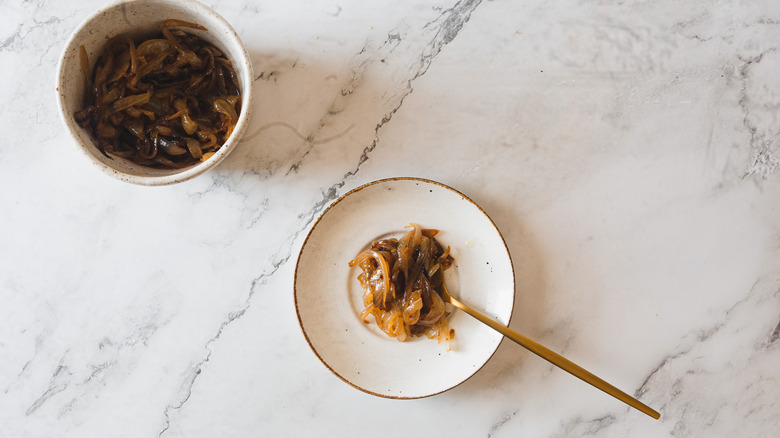
Ingredients
- 2-4 medium yellow onions
- 3 tablespoons extra virgin olive oil
- 3 tablespoons butter
- Salt, to taste
Optional Ingredients
- 1 teaspoon sugar
Directions
- Slice onions in half vertically, from the top to the roots. Rest onions face-down on the cutting board. Working horizontally, slice the onion into slices no more than ¼ or ½ inch thick. Repeat with all remaining onions.
- Set a non-stick pan to medium heat. Add the oil and butter to the pan and melt.
- Add enough onions to the pan that you fill the bottom without crowding or overlapping. Working in batches, cook the onions, stirring occasionally, for 1-2 minutes, until their color starts to turn translucent.
- Add more onions to the pan. Repeat this process until you are all out of raw onion slivers.
- Once all your onions are in the pan and have become translucent, lower the heat to medium-low.
- Continue cooking the onions, stirring them often, for about 20 minutes. This creates yellow-golden onions that still retain some texture.
- To caramelize onions to a medium consistency, continue cooking for another 15-20 minutes. Stir often, adding splashes of water to prevent burning.
- For dark brown caramelized onion jam, continue cooking for another 15-20 minutes, stirring often and adding water as needed.
- To speed up the process of sauteing onions, add 1 teaspoon of sugar after about 15-20 minutes of cooking.
Nutrition
| Calories per Serving | 133 |
| Total Fat | 12.6 g |
| Saturated Fat | 4.6 g |
| Trans Fat | 0.2 g |
| Cholesterol | 15.3 mg |
| Total Carbohydrates | 5.1 g |
| Dietary Fiber | 0.9 g |
| Total Sugars | 2.3 g |
| Sodium | 160.1 mg |
| Protein | 0.7 g |
